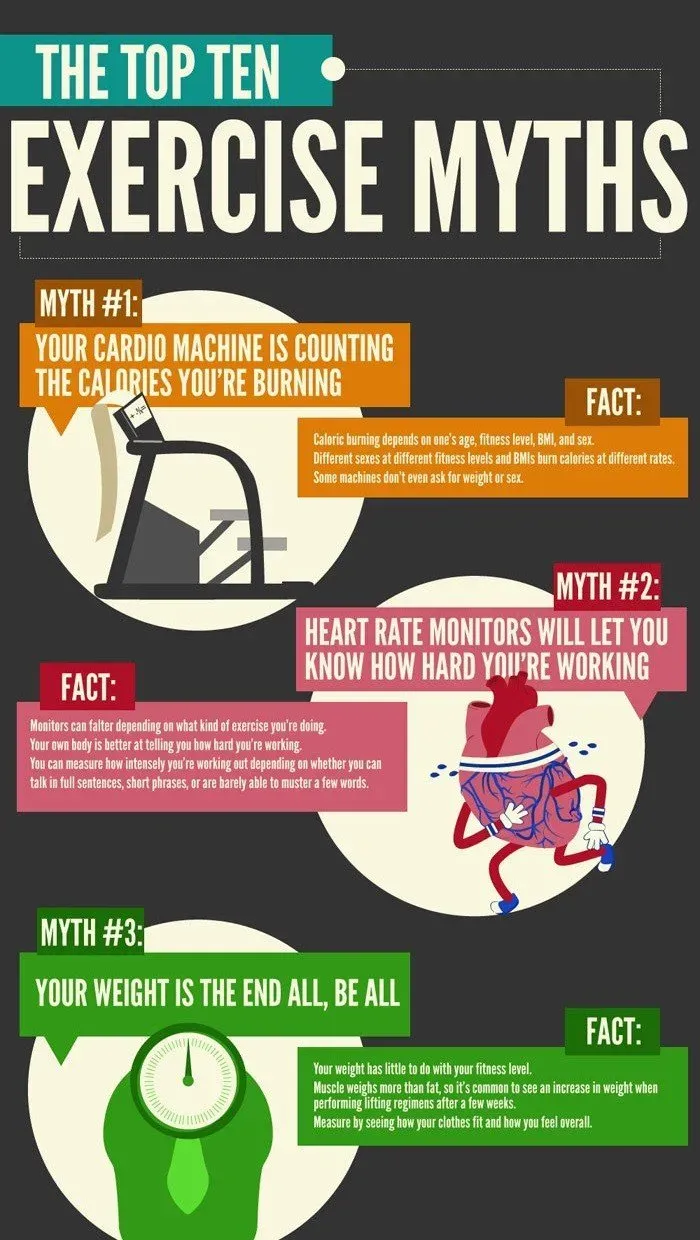Fitness Myths: Debunking Common Misconceptions
In the ever-evolving realm of health, *fitness myths* often mislead individuals on their journeys to better wellness. Common misconceptions can make fitness seem more complicated than it really is, causing many to shy away from effective strategies like *weightlifting for women* or the critical *importance of carbohydrates*. One of the most persistent myths suggests that more sweat equals a better workout, while in reality, it is the workout’s intensity that truly matters. Furthermore, the idea of *spot reduction*—that specific exercises can eliminate fat from targeted areas—is not supported by science. Understanding these misconceptions is crucial, as it empowers you to focus on facts that can genuinely enhance your fitness regimen, including the significance of adequate *rest days in fitness* for recovery.
In the intricate world of physical fitness and nutrition, many popular beliefs can hinder your progress. These prevalent *fitness misconceptions* can create barriers to achieving health goals, particularly around topics like *strength training for women* and the necessity of carbohydrates in a diet. It’s essential to look beyond surface-level advice, as some people wrongly assume that sweating profusely indicates a more effective workout. Moreover, the myth surrounding the possibility of *targeted fat loss* continues to confuse individuals striving for a healthier body. By addressing these fallacies and replacing them with evidence-based insights, you can cultivate a well-rounded approach to fitness that prioritizes proven techniques over outdated beliefs.
The Truth Behind Spot Reduction: Myth vs. Reality
Spot reduction is one of the most widely believed misconceptions in the fitness realm. Many individuals are convinced that targeting specific muscles through exercises like crunches or leg raises can lead to localized fat loss. However, the reality is that our bodies burn fat as a whole, and no amount of targeted exercises can magically eliminate fat in one area. To effectively burn fat, a comprehensive approach that includes cardiovascular workouts, strength training, and a healthy diet is necessary. Emphasizing this holistic perspective allows individuals to achieve their fitness goals more effectively.
To align your exercise routine with effective fat loss, consider incorporating both strength training and cardio into your regimen. These not only enhance muscle tone but also boost your metabolism, leading to overall fat loss. Moreover, maintaining a balanced, nutritious diet rich in whole foods supports your body’s energy needs while contributing to sustainable weight management. Understanding that spot reduction is a myth can help you focus on building a well-rounded fitness program that truly benefits your health.
Debunking the Weightlifting Myth: Women and Strength Training
For years, the myth that weightlifting makes women bulky has discouraged many from integrating strength training into their fitness routines. Scientific evidence suggests otherwise; women typically lack the testosterone levels necessary to develop significant muscle mass akin to men. Instead, lifting weights can lead to a toned physique, improved strength, and enhanced metabolic rate. The truth is that the benefits of strength training are plentiful, especially for women seeking to improve their overall health and body composition.
Engaging in regular strength training helps women increase bone density, which is vital for long-term health as it reduces the risk of osteoporosis. Additionally, adding muscle mass through weightlifting can boost metabolism, enabling more effective weight management. Women should embrace weightlifting as an essential component of their fitness strategy, rather than shying away due to misconceptions about bulking up.
Understanding the Role of Sweat During Workouts
It’s easy to think that the more you sweat, the better your workout is, but this is a misleading notion. Sweating is the body’s natural mechanism for regulating temperature, and the volume of sweat produced during a workout doesn’t necessarily correlate with calories burned or workout quality. Factors such as ambient temperature, humidity, and individual physiology can all impact how much someone sweats.
Instead of focusing solely on sweat as a measure of workout effectiveness, individuals should prioritize the quality and intensity of their exercise sessions. Aim for higher intensity workouts that challenge your cardiovascular fitness and strength instead of aiming just to break a sweat. Understanding this distinction can lead to more effective and enjoyable training sessions.
The Significance of Rest Days in Fitness Programs
Rest days are often undervalued in the fitness world, with some believing that more workouts lead to quicker results. However, research shows that integrating rest days into your fitness regimen is crucial for recovery and performance enhancement. Overworking can lead to fatigue, burnout, and an increased risk of injury, hindering overall progress.
Incorporating rest allows muscles to recover and rebuild, which is essential for growth and strength gains. Rest days also positively impact mental health by preventing workout burnout. Fitness should be a sustainable journey, and allowing yourself time to recover is just as important as the actual workout days.
The Importance of Carbohydrates in Fitness Nutrition
Carbohydrates often face unnecessary demonization in various diet trends, but they play an essential role in fueling the body, particularly for individuals engaged in regular workouts. Carbs are the body’s primary source of energy, and eliminating them can lead to decreased performance and fatigue. It’s crucial to differentiate between simple and complex carbohydrates to make healthier choices.
Incorporating nutrient-dense carbohydrates such as whole grains, fruits, and vegetables provides essential vitamins and minerals necessary for optimal health. Rather than viewing carbs as the enemy, framing them as a vital part of a balanced diet can empower individuals to make informed nutrition choices that support their fitness goals.
The Reality of Fitness Myths: What You Should Know
In a world filled with fitness information, separating fact from fiction becomes essential for effective progress. Common fitness myths, like spot reduction and the dangers of carbohydrates, can steer your health journey in the wrong direction. It’s essential to rely on credible sources and scientific research when crafting your fitness regimen, ensuring that your approach is not based on misconceptions.
Consistent education about these myths can create a more informed public, leading to better decision-making in fitness and nutrition. By prioritizing evidence-based practices, individuals can foster a healthier relationship with exercise and food, ultimately facilitating lasting lifestyle changes.
Building a Balanced Fitness Routine: Key Elements to Include
Creating a balanced fitness routine involves integrating diverse elements that contribute to overall health. This includes strength training, cardiovascular workouts, flexibility exercises, and crucially, rest periods. Each aspect plays a significant role in developing a well-rounded fitness program that promotes strength while preventing injury.
Moreover, an effective routine should also account for nutritional considerations, ensuring that you deliver adequate energy, especially through the consumption of carbohydrates. A thoughtful blend of workout types and an understanding of nutrition will enhance your physical fitness and support long-term wellness.
The Science of Effective Weight Loss Strategies
To achieve effective weight loss, numerous strategies come into play, with a focus on long-term sustainability rather than rapid results. Myths surrounding quick fixes or extreme diets often lead to disappointment. Instead, adopting a balanced approach that involves regular exercise, a nutritious diet, and realistic goal-setting is key to success.
Integrating strength training and cardio can significantly boost your metabolic rate, while also supporting sustainable fat loss. Emphasizing healthy eating habits over drastic diet restrictions will ensure your body receives all the necessary nutrients to function optimally, thus creating a favorable environment for effective weight loss.
Challenging Fitness Stereotypes: A Call to Action
Fitness stereotypes can thwart individual progress, painting an unrealistic picture of what working out should be. Many people feel pressure to conform to these stereotypes, believing they have to look a certain way or follow specific routines to be successful. Challenging these myths frees individuals to explore what fitness truly means to them based on personal goals and preferences.
Building an inclusive fitness culture starts with educating ourselves and others about the diversity of fitness experiences. Encouraging open dialogue about fitness myths enables all individuals, regardless of their backgrounds, to find empowerment through exercise and seek out paths that align with their unique aspirations. This call to action can significantly create a more supportive and understanding fitness community.
Frequently Asked Questions
What are the common fitness myths related to weightlifting for women?
One of the most prevalent fitness myths is that weightlifting makes women bulky. This misconception discourages many from strength training. In reality, women typically lack the testosterone levels necessary for significant muscle growth. Instead, weightlifting helps women build strength, boost metabolism, and enhance overall body composition.
Is spot reduction a valid approach to losing fat in specific areas?
The idea of spot reduction, or targeting fat loss in specific areas through concentrated exercises, is a common fitness myth. Studies show that fat loss occurs throughout the body and not in isolated areas. Effective fat loss requires a combination of cardiovascular exercise, strength training, and a healthy diet.
Does sweating during workouts mean I’m burning more calories?
Many believe that more sweat indicates an effective workout, but this is a misleading fitness myth. Sweating helps regulate body temperature and does not correlate with calorie burn. Instead of focusing on sweat levels, prioritize workout intensity and quality for better results.
Are rest days in fitness really necessary for progress?
Yes, the belief that daily workouts are essential for success is a significant fitness myth. Rest days are critical for recovery, muscle growth, and preventing burnout. Overtraining can lead to injuries, so it’s important to incorporate rest days into your fitness regimen.
Is the importance of carbohydrates in a fitness diet overstated?
Carbohydrates are often misunderstood in fitness dialogue, leading to the myth that they are ‘bad.’ In reality, they are crucial for energy, especially for active individuals. Quality sources of carbs, such as whole grains and fruits, provide necessary nutrients and should be a part of a balanced diet.
Do women really need to avoid weights to stay lean?
This is one of the most common fitness myths. Many women believe they should avoid weightlifting to stay lean. However, incorporating strength training can actually enhance lean body mass and improve metabolism, leading to a healthier and more toned physique.
Can you shape your body through spot exercises like crunches?
The belief that certain exercises like crunches can specifically shape targeted areas is a fitness myth. Fat loss is a full-body process, and to achieve a toned abdomen, a combination of overall fat reduction and core strengthening exercises is necessary.
Does frequent stretching before workouts really prevent injuries?
While stretching is important, the belief that static stretching completely prevents injuries is a common fitness myth. Instead, dynamic warm-ups are more effective in preparing muscles for activity. It’s essential to properly warm up and incorporate varied exercises to mitigate injury risk.
Is it true that the more frequently you work out, the faster you will see results?
This fitness myth suggests that frequent workouts guarantee quicker results, but that’s not accurate. Quality workouts combined with proper rest and recovery are crucial for seeing progress. Overtraining can actually hinder improvements and lead to burnout.
Is a high-protein diet necessary for fitness success?
The belief that high-protein diets are essential for all fitness success is misleading. While protein is important for muscle recovery, it’s crucial to maintain a balanced diet that includes carbohydrates and fats to support overall energy levels and health.
| Fitness Myth | Explanation | Truth |
|---|---|---|
| Spot Reduction is Possible | Belief that targeting specific areas leads to fat loss in that area. | Fat loss occurs holistically and requires a combination of cardio, strength training, and diet. |
| Lifting Weights Makes Women Bulky | Myth that women will gain significant muscle mass from weightlifting. | Women generally lack the testosterone needed to bulk up; weightlifting is beneficial for strength and metabolism. |
| More Sweat Equals a Better Workout | Equating sweat with workout effectiveness. | Sweating regulates body temperature; workout intensity is more important than sweat. |
| You Need to Work Out Daily for Results | Belief that daily workouts are essential for achieving fitness goals. | Rest days are crucial for recovery and muscle growth. |
| Carbs are Bad for You | Negative perception of carbohydrates in diets. | Carbohydrates are vital for energy; focus on quality sources rather than cutting them out. |
Summary
Fitness myths can often mislead individuals on their health journeys, making it essential to distinguish fact from fiction. Educating yourself about these misconceptions can transform your approach to fitness, enabling you to make informed decisions. By focusing on evidence-based practices in exercise and nutrition, such as understanding that spot reduction is impossible, weightlifting benefits women, and that rest days are vital, you can foster a more balanced and effective fitness regimen. Empowering yourself with accurate knowledge will ultimately lead you to reach your fitness goals more efficiently and effectively.
#FitnessMyths #ExerciseFacts #WorkoutTruths #HealthKnowledge #FitnessEducation








